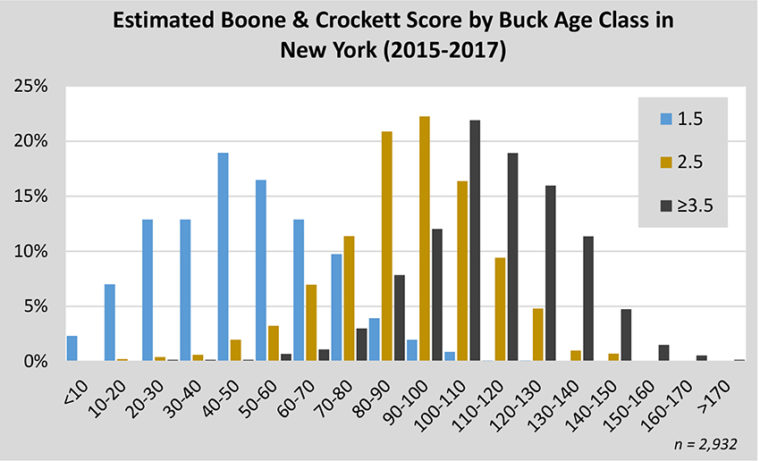It’s difficult to overstate the value of this chart for anyone trying to improve their deer hunting. It was produced by New York’s Department of Environmental Conservation (DEC) for their annual deer harvest summary, and it shows gross antler score by age for nearly 3,000 bucks killed by New York hunters from 2015 to 2017, the most recent years this particular data was collected by the state. No matter where you hunt, this chart shows us valuable lessons for understanding the complicated relationship between age and antler size.
Here are four lessons I can see very plainly in these colored bars.
1. Focus on Age, Not Antlers
Most importantly, the chart displays a truth about all whitetail populations, which is that bucks of any single age class will display a range of potential antler scores.
For example, look at the span of scores for yearlings. A 1½-year-old buck in New York could carry 10 inches of antler or 100! The rare bucks at these extremes are outliers from the average for their age, but if you are practicing Quality Deer Management (QDM) and want to see more high-scoring adult bucks, it’s crucial to recognize and pass those rare 70- to 100-inch yearlings. They’ll become those rare 130-inch 2½-year-olds and 150-inch older bucks. Do this by focusing on age, not antlers, when deciding which bucks to shoot.
2. Look at the Body When Aging
Look how much the age classes overlap each other in this chart. There’s a broad stretch in the middle of the chart, from around 70 to 100 inches, in which a buck of that score could potentially be any age at all, from 1½ to fully mature! Though a deer of that score in New York is most likely 2½, you cannot safely use gross score alone to estimate age.
This is why, in our “Age This” feature in our magazine and in our free weekly e-newsletter, NDA teaches hunters to estimate buck age in the field by primarily using body characteristics. Antler size may help as a secondary consideration when you can’t choose between two potential ages, but body is more important. You can’t safely assume small-antlered bucks are young and large-antlered bucks are old.
3. Celebrate Age as Much as Antlers
It’s very important to grasp that bucks with exceptional antler size are rare. Most bucks that make it to 3½-plus in New York score about 100 to 130 inches, as you can see above. It can be tough for a buck to reach this age in any area, so when you kill one, celebrate the occasion regardless of antler inches. Age matters! That was DEC’s point in sharing this graph with its hunters. Keep your expectations realistic for New York (or wherever you hunt). And when you kill an adult or fully mature buck, collect and save a jawbone as part of the story.
View this post on Instagram
4. How to Shift the Bell Curve to the Right
You see a bell-shaped or “bell-curve” distribution of score/age like this in all regions, though the span of actual scores will vary in states that produce larger-antlered deer on average. You can’t change the fact that some bucks have below-average antlers for their age, because you can’t manage genetics in wild deer. But you can shift the bell curve toward higher scores for all. How? In a word, nutrition. Improved nutrition across the entire year allows bucks and does to achieve their potential in body size, fawn recruitment, and antler size.
Each new year brings your opportunity to start or continue improving deer habitat and nutrition where you hunt. Let “habitat season” commence!
